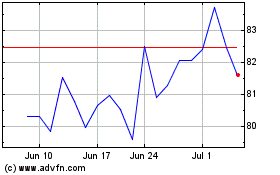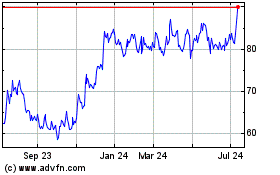Check 21 Second Anniversary Approaches: UMB Bank's Terry D'Amore Offers PerspectiveTerry D'Amore
October 10 2006 - 9:40AM
Business Wire
The decline in check volume is well-known and documented. In 2000,
checks represented the majority, 58 percent, of all non-cash
payments in the United States. Three years later, checks claimed
only 45 percent. Lower check volume means processing costs are
spread over a diminishing volume of checks. The Federal Reserve has
already begun to consolidate check-processing sites to minimize
their costs. For years, the banking industry has sought a more
efficient clearing strategy. In 2003, the Federal Reserve proposed
a solution to Congress. Enacted on October 28, 2004, the Check
Clearing for the 21st Century Act (Check 21) allowed a digital
image, or substitute check, to legally replace the original paper
check. With Check 21, the physical check stays put; instead, its
image and data are transmitted between financial institutions,
allowing checks to be cleared quicker. �Financial institutions have
been slow to adopt image conversion full-scale,� said Terry
D�Amore, executive vice president and director of the Payment &
Technology Solutions Division of UMB Bank. �The high entry cost for
banks to image all their items certainly has contributed to Check
21�s lukewarm welcome. Even though Check 21 has not triumphed as
the conversion of choice inside banks today, it has birthed an
innovation for business. Remote deposit allows corporate clients to
scan checks, literally at their desks, convert them to digital
images, and electronically transmit them to their financial
institution, saving them a trip to their local branch.� Check 21
has also driven unexpected competitive innovations, leading to yet
another reason why it hasn�t surfaced as the standard for check
conversion. Automated Clearing House (ACH) payments are making
significant forays into electronic check conversion and, soon,
across the business landscape. Where Check 21 converts check to
images whose data is read and stored through optical character
recognition, ACH converts checks to straight data. �The future of
check conversion is open,� said D�Amore. �Banks and businesses are
faced with two choices: Check 21 and check-to-image conversion, or
ACH and check-to-data conversion. Businesses aren�t going to stop
writing checks. And checks are going to be converted, either at the
site of business or at the bank. Business can opt for the usual,
leaving the choice of conversion up to their financial institution.
Or they can make the choice in their back office.� For further
insight or to schedule an interview with Terry D�Amore, please
contact Jeremy McNeive at 816-860-5088. UMB Financial Corporation
(NASDQ: UMBF) is a multi-bank holding company headquartered in
Kansas City, Mo., offering complete banking and related financial
services to both individual and business customers nationwide. Its
banking subsidiaries own and operate 141 banking centers throughout
Missouri, Illinois, Colorado, Kansas, Oklahoma, Nebraska and
Arizona. Subsidiaries of the holding company and the lead bank, UMB
Bank, n.a., include an investment services group based in
Milwaukee, Wisconsin, a trust management company in South Dakota,
and single-purpose companies that deal with brokerage services,
consulting services and insurance. UMB was named one of Business
Week's "Web Smart 50" companies in 2005. The decline in check
volume is well-known and documented. In 2000, checks represented
the majority, 58 percent, of all non-cash payments in the United
States. Three years later, checks claimed only 45 percent. Lower
check volume means processing costs are spread over a diminishing
volume of checks. The Federal Reserve has already begun to
consolidate check-processing sites to minimize their costs. For
years, the banking industry has sought a more efficient clearing
strategy. In 2003, the Federal Reserve proposed a solution to
Congress. Enacted on October 28, 2004, the Check Clearing for the
21st Century Act (Check 21) allowed a digital image, or substitute
check, to legally replace the original paper check. With Check 21,
the physical check stays put; instead, its image and data are
transmitted between financial institutions, allowing checks to be
cleared quicker. "Financial institutions have been slow to adopt
image conversion full-scale," said Terry D'Amore, executive vice
president and director of the Payment & Technology Solutions
Division of UMB Bank. "The high entry cost for banks to image all
their items certainly has contributed to Check 21's lukewarm
welcome. Even though Check 21 has not triumphed as the conversion
of choice inside banks today, it has birthed an innovation for
business. Remote deposit allows corporate clients to scan checks,
literally at their desks, convert them to digital images, and
electronically transmit them to their financial institution, saving
them a trip to their local branch." Check 21 has also driven
unexpected competitive innovations, leading to yet another reason
why it hasn't surfaced as the standard for check conversion.
Automated Clearing House (ACH) payments are making significant
forays into electronic check conversion and, soon, across the
business landscape. Where Check 21 converts check to images whose
data is read and stored through optical character recognition, ACH
converts checks to straight data. "The future of check conversion
is open," said D'Amore. "Banks and businesses are faced with two
choices: Check 21 and check-to-image conversion, or ACH and
check-to-data conversion. Businesses aren't going to stop writing
checks. And checks are going to be converted, either at the site of
business or at the bank. Business can opt for the usual, leaving
the choice of conversion up to their financial institution. Or they
can make the choice in their back office." For further insight or
to schedule an interview with Terry D'Amore, please contact Jeremy
McNeive at 816-860-5088. UMB Financial Corporation (NASDQ: UMBF) is
a multi-bank holding company headquartered in Kansas City, Mo.,
offering complete banking and related financial services to both
individual and business customers nationwide. Its banking
subsidiaries own and operate 141 banking centers throughout
Missouri, Illinois, Colorado, Kansas, Oklahoma, Nebraska and
Arizona. Subsidiaries of the holding company and the lead bank, UMB
Bank, n.a., include an investment services group based in
Milwaukee, Wisconsin, a trust management company in South Dakota,
and single-purpose companies that deal with brokerage services,
consulting services and insurance. UMB was named one of Business
Week's "Web Smart 50" companies in 2005.
UMB Financial (NASDAQ:UMBF)
Historical Stock Chart
From Jul 2024 to Aug 2024

UMB Financial (NASDAQ:UMBF)
Historical Stock Chart
From Aug 2023 to Aug 2024
